Conflicts in Reality TV | Case Studies
VerifiedAdded on 2022/08/25
|8
|1878
|32
AI Summary
Contribute Materials
Your contribution can guide someone’s learning journey. Share your
documents today.
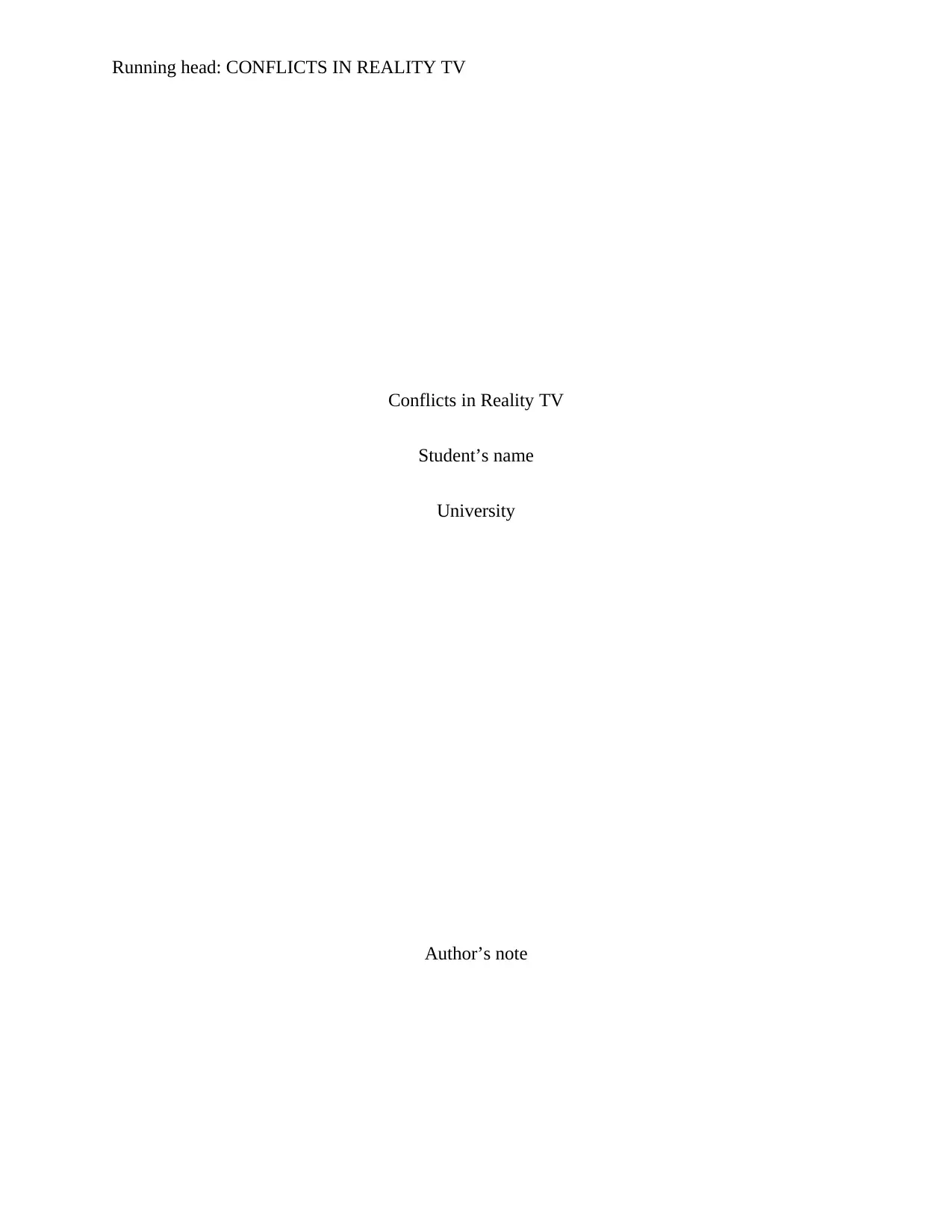
Running head: CONFLICTS IN REALITY TV
Conflicts in Reality TV
Student’s name
University
Author’s note
Conflicts in Reality TV
Student’s name
University
Author’s note
Secure Best Marks with AI Grader
Need help grading? Try our AI Grader for instant feedback on your assignments.
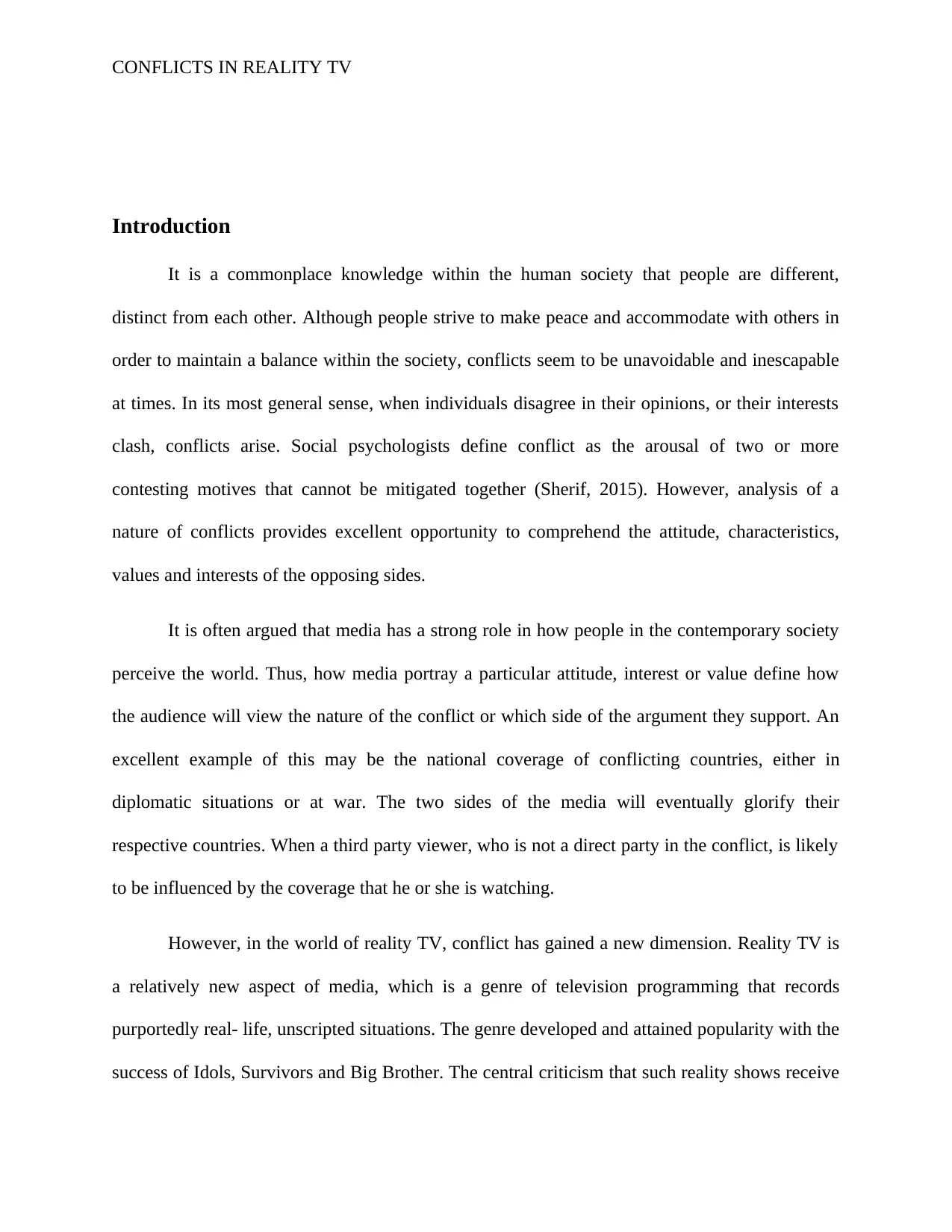
CONFLICTS IN REALITY TV
Introduction
It is a commonplace knowledge within the human society that people are different,
distinct from each other. Although people strive to make peace and accommodate with others in
order to maintain a balance within the society, conflicts seem to be unavoidable and inescapable
at times. In its most general sense, when individuals disagree in their opinions, or their interests
clash, conflicts arise. Social psychologists define conflict as the arousal of two or more
contesting motives that cannot be mitigated together (Sherif, 2015). However, analysis of a
nature of conflicts provides excellent opportunity to comprehend the attitude, characteristics,
values and interests of the opposing sides.
It is often argued that media has a strong role in how people in the contemporary society
perceive the world. Thus, how media portray a particular attitude, interest or value define how
the audience will view the nature of the conflict or which side of the argument they support. An
excellent example of this may be the national coverage of conflicting countries, either in
diplomatic situations or at war. The two sides of the media will eventually glorify their
respective countries. When a third party viewer, who is not a direct party in the conflict, is likely
to be influenced by the coverage that he or she is watching.
However, in the world of reality TV, conflict has gained a new dimension. Reality TV is
a relatively new aspect of media, which is a genre of television programming that records
purportedly real- life, unscripted situations. The genre developed and attained popularity with the
success of Idols, Survivors and Big Brother. The central criticism that such reality shows receive
Introduction
It is a commonplace knowledge within the human society that people are different,
distinct from each other. Although people strive to make peace and accommodate with others in
order to maintain a balance within the society, conflicts seem to be unavoidable and inescapable
at times. In its most general sense, when individuals disagree in their opinions, or their interests
clash, conflicts arise. Social psychologists define conflict as the arousal of two or more
contesting motives that cannot be mitigated together (Sherif, 2015). However, analysis of a
nature of conflicts provides excellent opportunity to comprehend the attitude, characteristics,
values and interests of the opposing sides.
It is often argued that media has a strong role in how people in the contemporary society
perceive the world. Thus, how media portray a particular attitude, interest or value define how
the audience will view the nature of the conflict or which side of the argument they support. An
excellent example of this may be the national coverage of conflicting countries, either in
diplomatic situations or at war. The two sides of the media will eventually glorify their
respective countries. When a third party viewer, who is not a direct party in the conflict, is likely
to be influenced by the coverage that he or she is watching.
However, in the world of reality TV, conflict has gained a new dimension. Reality TV is
a relatively new aspect of media, which is a genre of television programming that records
purportedly real- life, unscripted situations. The genre developed and attained popularity with the
success of Idols, Survivors and Big Brother. The central criticism that such reality shows receive
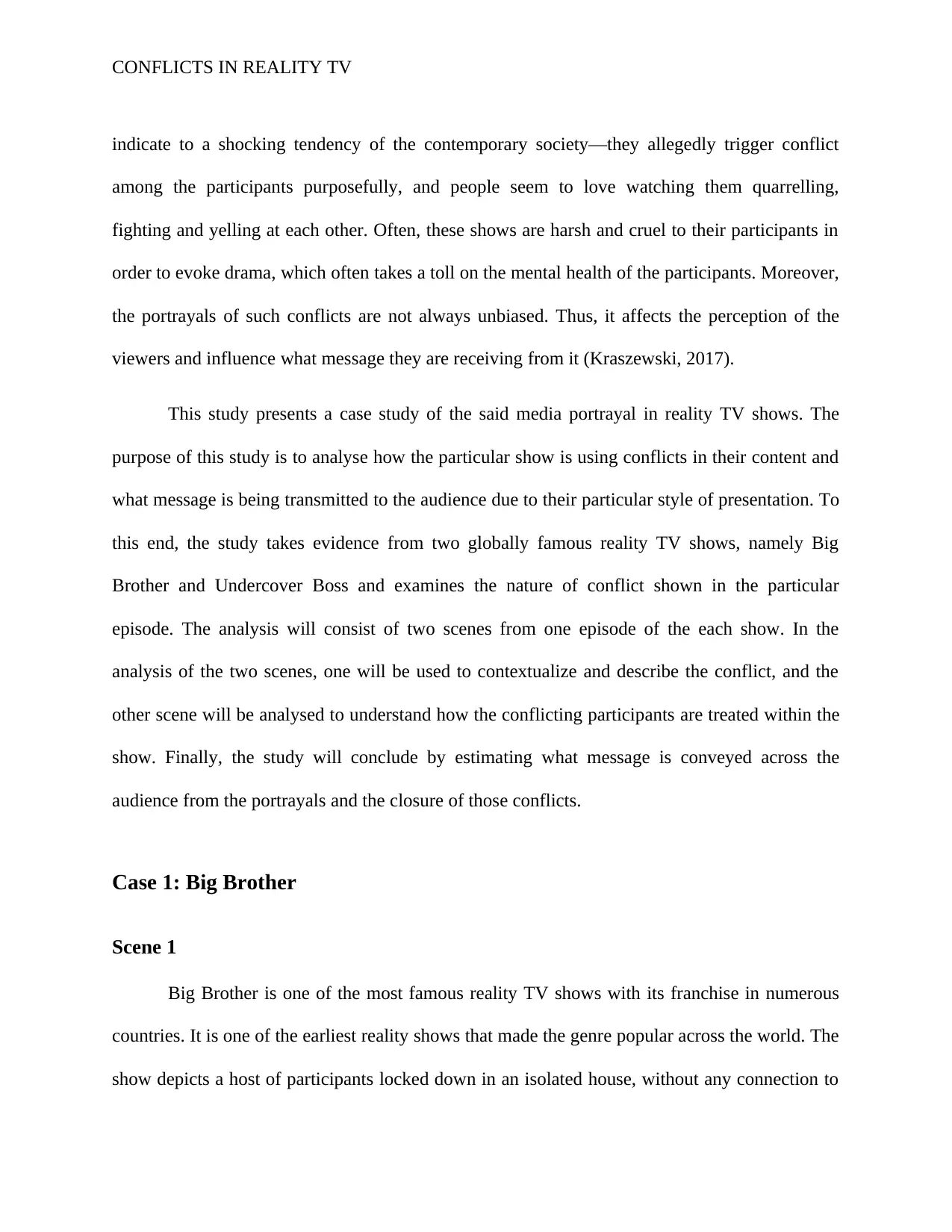
CONFLICTS IN REALITY TV
indicate to a shocking tendency of the contemporary society—they allegedly trigger conflict
among the participants purposefully, and people seem to love watching them quarrelling,
fighting and yelling at each other. Often, these shows are harsh and cruel to their participants in
order to evoke drama, which often takes a toll on the mental health of the participants. Moreover,
the portrayals of such conflicts are not always unbiased. Thus, it affects the perception of the
viewers and influence what message they are receiving from it (Kraszewski, 2017).
This study presents a case study of the said media portrayal in reality TV shows. The
purpose of this study is to analyse how the particular show is using conflicts in their content and
what message is being transmitted to the audience due to their particular style of presentation. To
this end, the study takes evidence from two globally famous reality TV shows, namely Big
Brother and Undercover Boss and examines the nature of conflict shown in the particular
episode. The analysis will consist of two scenes from one episode of the each show. In the
analysis of the two scenes, one will be used to contextualize and describe the conflict, and the
other scene will be analysed to understand how the conflicting participants are treated within the
show. Finally, the study will conclude by estimating what message is conveyed across the
audience from the portrayals and the closure of those conflicts.
Case 1: Big Brother
Scene 1
Big Brother is one of the most famous reality TV shows with its franchise in numerous
countries. It is one of the earliest reality shows that made the genre popular across the world. The
show depicts a host of participants locked down in an isolated house, without any connection to
indicate to a shocking tendency of the contemporary society—they allegedly trigger conflict
among the participants purposefully, and people seem to love watching them quarrelling,
fighting and yelling at each other. Often, these shows are harsh and cruel to their participants in
order to evoke drama, which often takes a toll on the mental health of the participants. Moreover,
the portrayals of such conflicts are not always unbiased. Thus, it affects the perception of the
viewers and influence what message they are receiving from it (Kraszewski, 2017).
This study presents a case study of the said media portrayal in reality TV shows. The
purpose of this study is to analyse how the particular show is using conflicts in their content and
what message is being transmitted to the audience due to their particular style of presentation. To
this end, the study takes evidence from two globally famous reality TV shows, namely Big
Brother and Undercover Boss and examines the nature of conflict shown in the particular
episode. The analysis will consist of two scenes from one episode of the each show. In the
analysis of the two scenes, one will be used to contextualize and describe the conflict, and the
other scene will be analysed to understand how the conflicting participants are treated within the
show. Finally, the study will conclude by estimating what message is conveyed across the
audience from the portrayals and the closure of those conflicts.
Case 1: Big Brother
Scene 1
Big Brother is one of the most famous reality TV shows with its franchise in numerous
countries. It is one of the earliest reality shows that made the genre popular across the world. The
show depicts a host of participants locked down in an isolated house, without any connection to
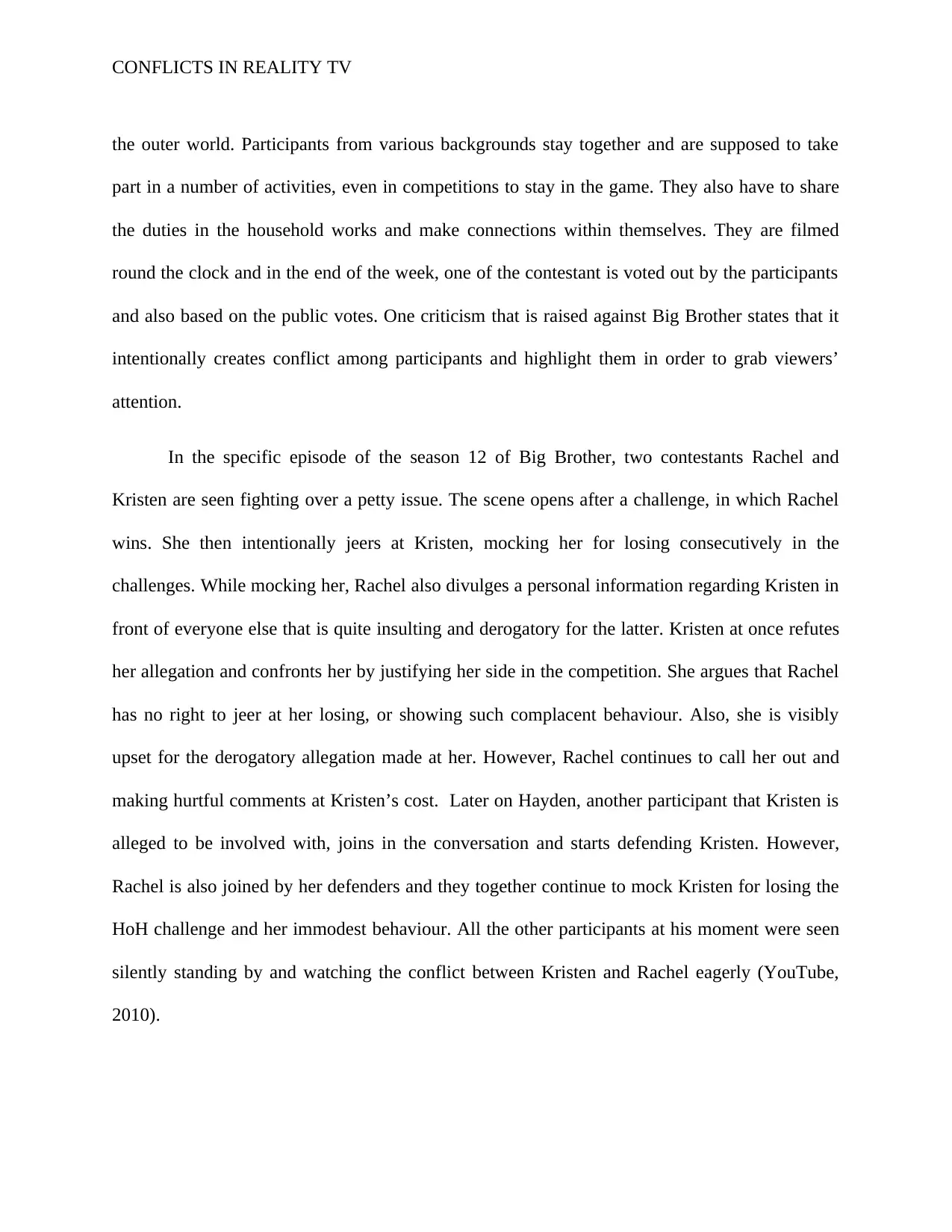
CONFLICTS IN REALITY TV
the outer world. Participants from various backgrounds stay together and are supposed to take
part in a number of activities, even in competitions to stay in the game. They also have to share
the duties in the household works and make connections within themselves. They are filmed
round the clock and in the end of the week, one of the contestant is voted out by the participants
and also based on the public votes. One criticism that is raised against Big Brother states that it
intentionally creates conflict among participants and highlight them in order to grab viewers’
attention.
In the specific episode of the season 12 of Big Brother, two contestants Rachel and
Kristen are seen fighting over a petty issue. The scene opens after a challenge, in which Rachel
wins. She then intentionally jeers at Kristen, mocking her for losing consecutively in the
challenges. While mocking her, Rachel also divulges a personal information regarding Kristen in
front of everyone else that is quite insulting and derogatory for the latter. Kristen at once refutes
her allegation and confronts her by justifying her side in the competition. She argues that Rachel
has no right to jeer at her losing, or showing such complacent behaviour. Also, she is visibly
upset for the derogatory allegation made at her. However, Rachel continues to call her out and
making hurtful comments at Kristen’s cost. Later on Hayden, another participant that Kristen is
alleged to be involved with, joins in the conversation and starts defending Kristen. However,
Rachel is also joined by her defenders and they together continue to mock Kristen for losing the
HoH challenge and her immodest behaviour. All the other participants at his moment were seen
silently standing by and watching the conflict between Kristen and Rachel eagerly (YouTube,
2010).
the outer world. Participants from various backgrounds stay together and are supposed to take
part in a number of activities, even in competitions to stay in the game. They also have to share
the duties in the household works and make connections within themselves. They are filmed
round the clock and in the end of the week, one of the contestant is voted out by the participants
and also based on the public votes. One criticism that is raised against Big Brother states that it
intentionally creates conflict among participants and highlight them in order to grab viewers’
attention.
In the specific episode of the season 12 of Big Brother, two contestants Rachel and
Kristen are seen fighting over a petty issue. The scene opens after a challenge, in which Rachel
wins. She then intentionally jeers at Kristen, mocking her for losing consecutively in the
challenges. While mocking her, Rachel also divulges a personal information regarding Kristen in
front of everyone else that is quite insulting and derogatory for the latter. Kristen at once refutes
her allegation and confronts her by justifying her side in the competition. She argues that Rachel
has no right to jeer at her losing, or showing such complacent behaviour. Also, she is visibly
upset for the derogatory allegation made at her. However, Rachel continues to call her out and
making hurtful comments at Kristen’s cost. Later on Hayden, another participant that Kristen is
alleged to be involved with, joins in the conversation and starts defending Kristen. However,
Rachel is also joined by her defenders and they together continue to mock Kristen for losing the
HoH challenge and her immodest behaviour. All the other participants at his moment were seen
silently standing by and watching the conflict between Kristen and Rachel eagerly (YouTube,
2010).
Secure Best Marks with AI Grader
Need help grading? Try our AI Grader for instant feedback on your assignments.
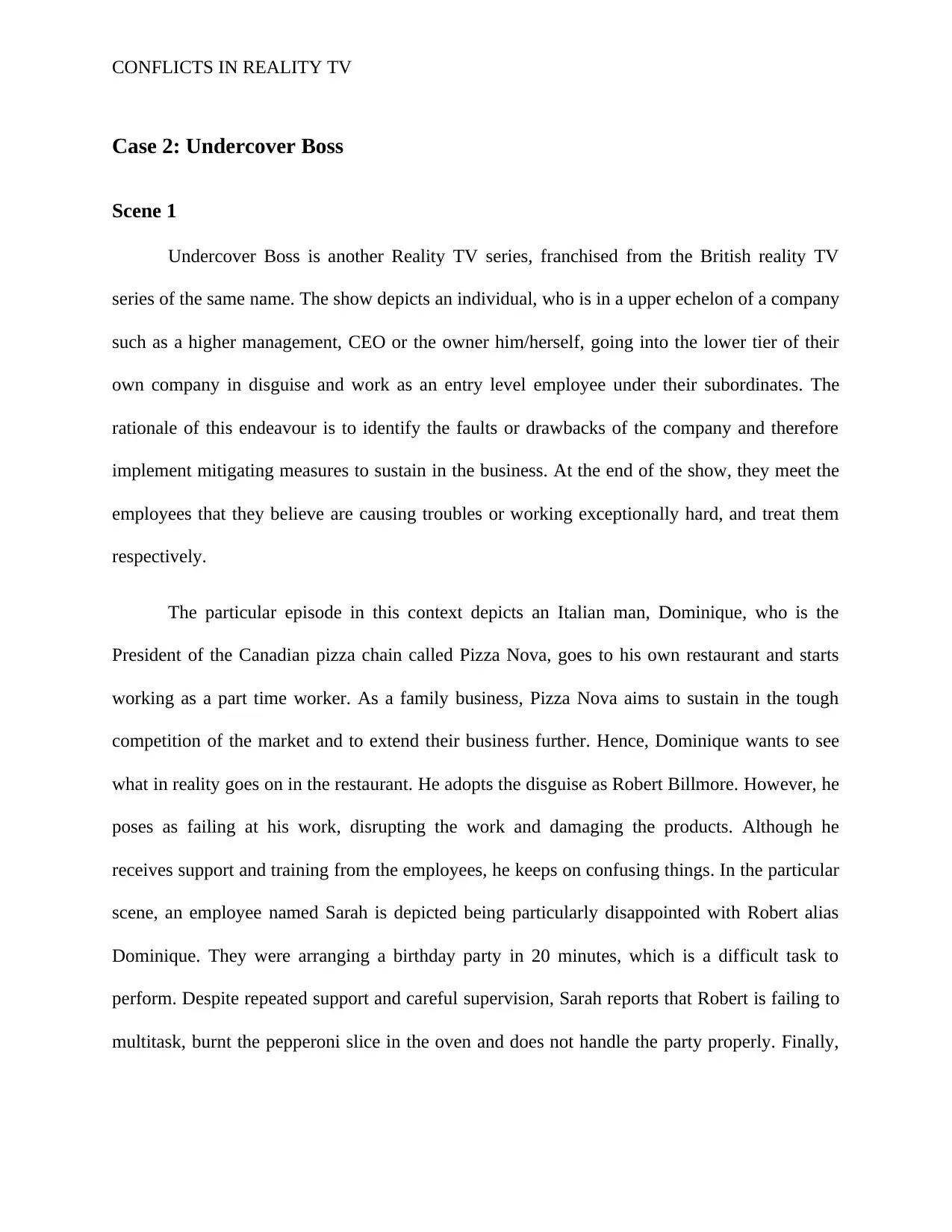
CONFLICTS IN REALITY TV
Case 2: Undercover Boss
Scene 1
Undercover Boss is another Reality TV series, franchised from the British reality TV
series of the same name. The show depicts an individual, who is in a upper echelon of a company
such as a higher management, CEO or the owner him/herself, going into the lower tier of their
own company in disguise and work as an entry level employee under their subordinates. The
rationale of this endeavour is to identify the faults or drawbacks of the company and therefore
implement mitigating measures to sustain in the business. At the end of the show, they meet the
employees that they believe are causing troubles or working exceptionally hard, and treat them
respectively.
The particular episode in this context depicts an Italian man, Dominique, who is the
President of the Canadian pizza chain called Pizza Nova, goes to his own restaurant and starts
working as a part time worker. As a family business, Pizza Nova aims to sustain in the tough
competition of the market and to extend their business further. Hence, Dominique wants to see
what in reality goes on in the restaurant. He adopts the disguise as Robert Billmore. However, he
poses as failing at his work, disrupting the work and damaging the products. Although he
receives support and training from the employees, he keeps on confusing things. In the particular
scene, an employee named Sarah is depicted being particularly disappointed with Robert alias
Dominique. They were arranging a birthday party in 20 minutes, which is a difficult task to
perform. Despite repeated support and careful supervision, Sarah reports that Robert is failing to
multitask, burnt the pepperoni slice in the oven and does not handle the party properly. Finally,
Case 2: Undercover Boss
Scene 1
Undercover Boss is another Reality TV series, franchised from the British reality TV
series of the same name. The show depicts an individual, who is in a upper echelon of a company
such as a higher management, CEO or the owner him/herself, going into the lower tier of their
own company in disguise and work as an entry level employee under their subordinates. The
rationale of this endeavour is to identify the faults or drawbacks of the company and therefore
implement mitigating measures to sustain in the business. At the end of the show, they meet the
employees that they believe are causing troubles or working exceptionally hard, and treat them
respectively.
The particular episode in this context depicts an Italian man, Dominique, who is the
President of the Canadian pizza chain called Pizza Nova, goes to his own restaurant and starts
working as a part time worker. As a family business, Pizza Nova aims to sustain in the tough
competition of the market and to extend their business further. Hence, Dominique wants to see
what in reality goes on in the restaurant. He adopts the disguise as Robert Billmore. However, he
poses as failing at his work, disrupting the work and damaging the products. Although he
receives support and training from the employees, he keeps on confusing things. In the particular
scene, an employee named Sarah is depicted being particularly disappointed with Robert alias
Dominique. They were arranging a birthday party in 20 minutes, which is a difficult task to
perform. Despite repeated support and careful supervision, Sarah reports that Robert is failing to
multitask, burnt the pepperoni slice in the oven and does not handle the party properly. Finally,

CONFLICTS IN REALITY TV
he serves an enormous cake slice to a child to Sarah’s disapproval, and she opines that he is not
fit for the job (YouTube, 2014).
Case 1 Big Brother
Scene 2
The conflict that is depicted in the episode was rather highlighted, and the entire episode
was built on that tension. Interestingly, the other participants were shown as enjoying the tension
between Rachel and Kristen, when some of them even reported during the ‘confession session’
that they were expecting some high level drama and enjoyed the fight thoroughly. Some of the
male participants even made some sexist remarks at the cost of the female participants, and
described it as a much-awaited ‘cat-fight’. The remarks shown in the scene of confession session
indicated that none of the participants other than Hayden and Kathy were ready to take Kristen’s
side. Most importantly, none of them reported Rachel’s behaviour as unacceptable or derogatory;
rather they made fun of Kristen for being emotional (YouTube, 2010).
Case 2: Undercover Boss
Scene 2
In the end of the episode, Dominique is seen sitting at his office and meeting all the
employees that he met during his undercover training. He is also seen treating Sarah, with whom
he apparently got into a conflict, with extreme politeness and respect, stating that he would
implement every strategy and development ideas Sarah had suggested unknowingly. He also
offers Sarah a better position following her passion for working with kids, and presents her with
a brand new car (YouTube, 2014).
he serves an enormous cake slice to a child to Sarah’s disapproval, and she opines that he is not
fit for the job (YouTube, 2014).
Case 1 Big Brother
Scene 2
The conflict that is depicted in the episode was rather highlighted, and the entire episode
was built on that tension. Interestingly, the other participants were shown as enjoying the tension
between Rachel and Kristen, when some of them even reported during the ‘confession session’
that they were expecting some high level drama and enjoyed the fight thoroughly. Some of the
male participants even made some sexist remarks at the cost of the female participants, and
described it as a much-awaited ‘cat-fight’. The remarks shown in the scene of confession session
indicated that none of the participants other than Hayden and Kathy were ready to take Kristen’s
side. Most importantly, none of them reported Rachel’s behaviour as unacceptable or derogatory;
rather they made fun of Kristen for being emotional (YouTube, 2010).
Case 2: Undercover Boss
Scene 2
In the end of the episode, Dominique is seen sitting at his office and meeting all the
employees that he met during his undercover training. He is also seen treating Sarah, with whom
he apparently got into a conflict, with extreme politeness and respect, stating that he would
implement every strategy and development ideas Sarah had suggested unknowingly. He also
offers Sarah a better position following her passion for working with kids, and presents her with
a brand new car (YouTube, 2014).
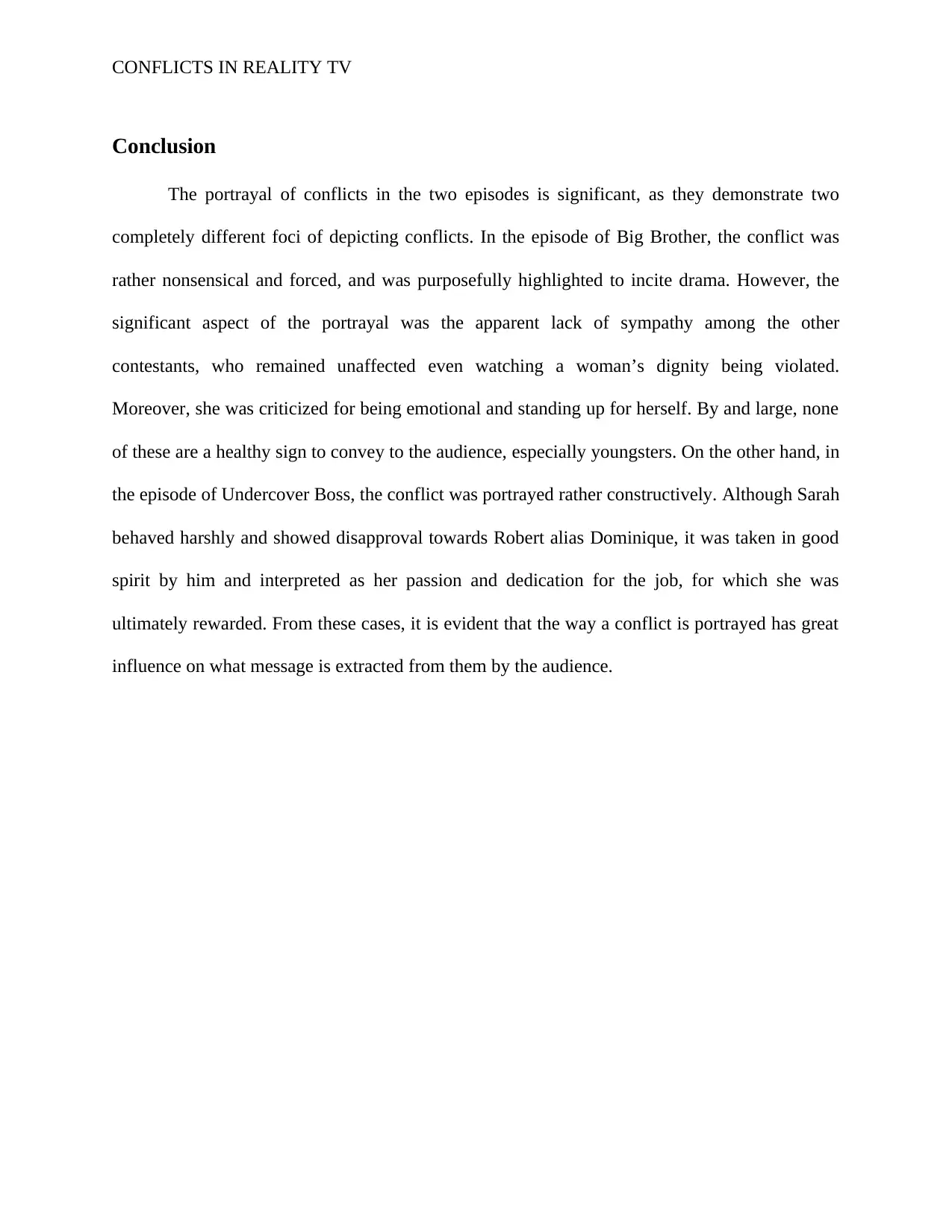
CONFLICTS IN REALITY TV
Conclusion
The portrayal of conflicts in the two episodes is significant, as they demonstrate two
completely different foci of depicting conflicts. In the episode of Big Brother, the conflict was
rather nonsensical and forced, and was purposefully highlighted to incite drama. However, the
significant aspect of the portrayal was the apparent lack of sympathy among the other
contestants, who remained unaffected even watching a woman’s dignity being violated.
Moreover, she was criticized for being emotional and standing up for herself. By and large, none
of these are a healthy sign to convey to the audience, especially youngsters. On the other hand, in
the episode of Undercover Boss, the conflict was portrayed rather constructively. Although Sarah
behaved harshly and showed disapproval towards Robert alias Dominique, it was taken in good
spirit by him and interpreted as her passion and dedication for the job, for which she was
ultimately rewarded. From these cases, it is evident that the way a conflict is portrayed has great
influence on what message is extracted from them by the audience.
Conclusion
The portrayal of conflicts in the two episodes is significant, as they demonstrate two
completely different foci of depicting conflicts. In the episode of Big Brother, the conflict was
rather nonsensical and forced, and was purposefully highlighted to incite drama. However, the
significant aspect of the portrayal was the apparent lack of sympathy among the other
contestants, who remained unaffected even watching a woman’s dignity being violated.
Moreover, she was criticized for being emotional and standing up for herself. By and large, none
of these are a healthy sign to convey to the audience, especially youngsters. On the other hand, in
the episode of Undercover Boss, the conflict was portrayed rather constructively. Although Sarah
behaved harshly and showed disapproval towards Robert alias Dominique, it was taken in good
spirit by him and interpreted as her passion and dedication for the job, for which she was
ultimately rewarded. From these cases, it is evident that the way a conflict is portrayed has great
influence on what message is extracted from them by the audience.
Paraphrase This Document
Need a fresh take? Get an instant paraphrase of this document with our AI Paraphraser
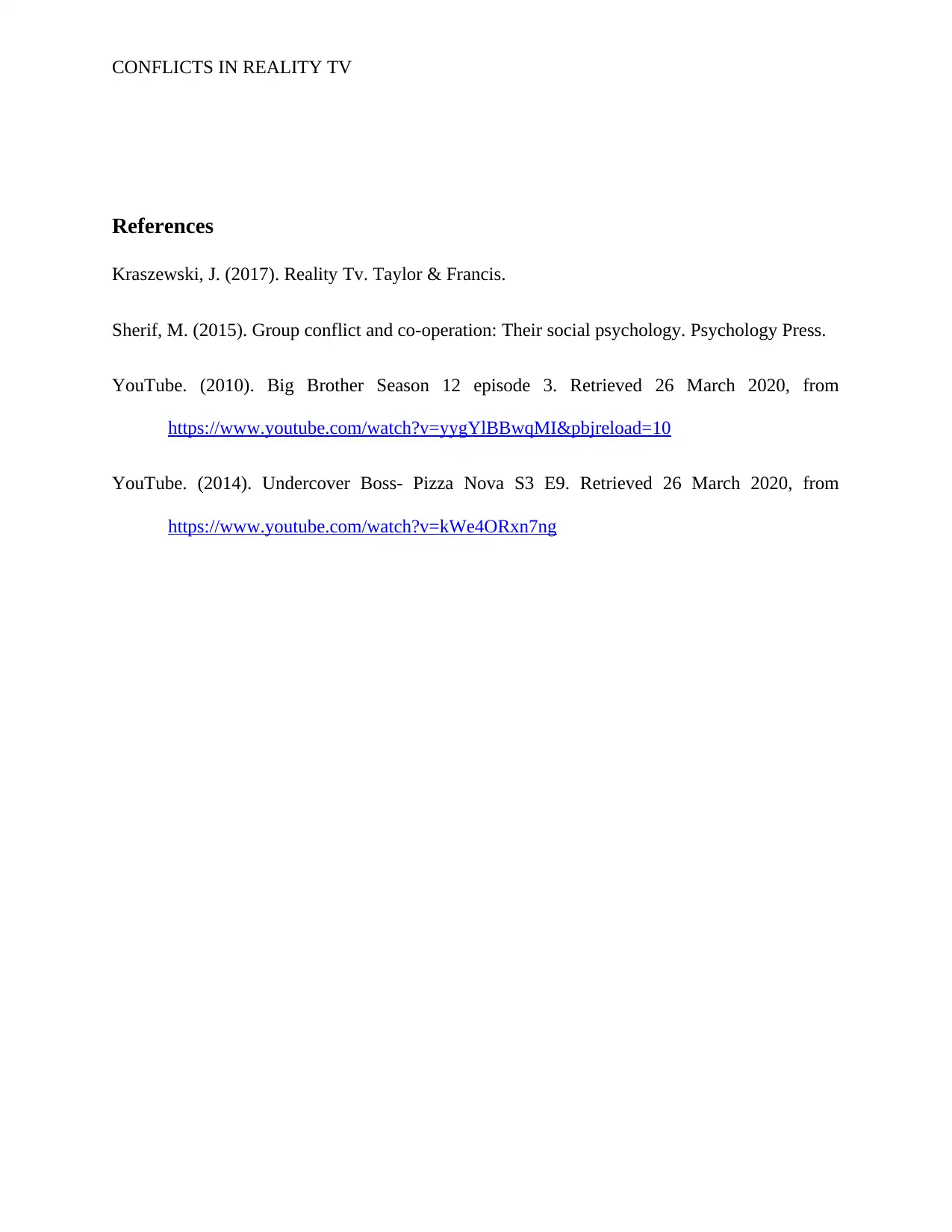
CONFLICTS IN REALITY TV
References
Kraszewski, J. (2017). Reality Tv. Taylor & Francis.
Sherif, M. (2015). Group conflict and co-operation: Their social psychology. Psychology Press.
YouTube. (2010). Big Brother Season 12 episode 3. Retrieved 26 March 2020, from
https://www.youtube.com/watch?v=yygYlBBwqMI&pbjreload=10
YouTube. (2014). Undercover Boss- Pizza Nova S3 E9. Retrieved 26 March 2020, from
https://www.youtube.com/watch?v=kWe4ORxn7ng
References
Kraszewski, J. (2017). Reality Tv. Taylor & Francis.
Sherif, M. (2015). Group conflict and co-operation: Their social psychology. Psychology Press.
YouTube. (2010). Big Brother Season 12 episode 3. Retrieved 26 March 2020, from
https://www.youtube.com/watch?v=yygYlBBwqMI&pbjreload=10
YouTube. (2014). Undercover Boss- Pizza Nova S3 E9. Retrieved 26 March 2020, from
https://www.youtube.com/watch?v=kWe4ORxn7ng
1 out of 8
Your All-in-One AI-Powered Toolkit for Academic Success.
+13062052269
info@desklib.com
Available 24*7 on WhatsApp / Email
![[object Object]](/_next/static/media/star-bottom.7253800d.svg)
Unlock your academic potential
© 2024 | Zucol Services PVT LTD | All rights reserved.

